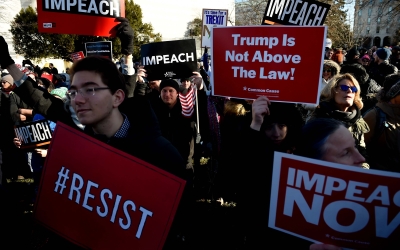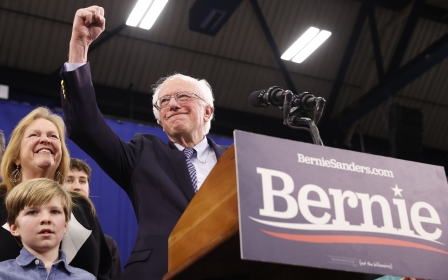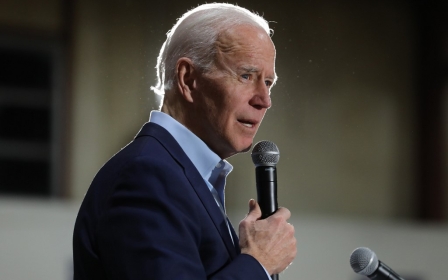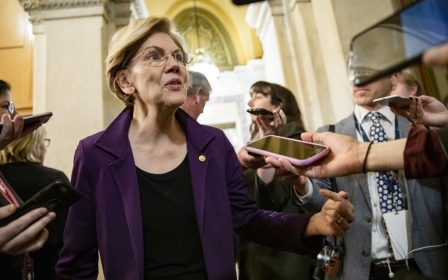The Iowa caucuses are hugely important. Here's how they work

As this year's US elections near, whoever wins the Democratic nomination for president could have an enormous effect on how Washington operates in the Middle East.
Senator Bernie Sanders has vowed to impose conditions on US aid to Israel to try and compel it to change its relationship with the Palestinians.
Senator Elizabeth Warren has pledged to withdraw US combat troops from the Middle East.
Meanwhile, former Vice President Joe Biden wants to turn Saudi Arabia into a "pariah state".
The Iowa contest is not technically an election
With the campaign to nominate a Democratic candidate beginning in Iowa this Monday, this first contest is crucial in separating top-tier candidates from those who have failed to gain traction in the race for the White House.
Barack Obama, Hillary Clinton and Al Gore all came first in Iowa and went on to win the party's nomination.
So winning the state will serve as a massive boost to the top candidate who aims to unseat US President Donald Trump in November.
Here's how it works
Iowa, a sparsely populated heartland state of just 3.1 million people, has an outsized influence on the American elections and subsequently global affairs.
But the Iowa contest is not technically an election. It is an unusual process known as caucuses, where instead of casting a ballot, participants - known as caucus-goers, not voters - elect their favourite candidates with their feet, by literally standing for her or him.
On caucus night, starting at 7 pm, participants meet up at designated locations known as precincts. A school cafeteria, a city hall, a church or even someone's home can serve as a precinct.
Each candidate will have a specific spot at the precinct and volunteers try to court caucus-goers to join their group. After all is said and done, a first-count happens.
According to new rules introduced this cycle, those standing for a candidate who meets the viability threshold, get their votes locked in.
For most locations that threshold is 15 percent of the overall participants, although it can be higher in small precincts.
For candidates who do not meet that minimum margin of support, the "votes" of the caucus-goers who support them are no longer viable.
At this point, supporters of other candidates start wooing the backers of non-viable campaigns within the precinct.
It is also possible for supporters of presidential hopefuls close to the viability threshold to try to convince other caucus-goers for other non-viable candidates.
When that convincing procedure concludes, a second and final count takes place.
Then the allocation of delegates happens, and here's where things get complicated.
Delegates are awarded proportionally. A candidate gets the same ratio of the total number of delegates for a precinct as his or her ratio of the total number or caucus-goers.
The formula is as follows: The number of supporters for a candidate multiplied by the number of delegates for the precinct divided by the overall number caucus-goers at that location.
Because delegates are actual humans who would be assigned to support their candidate at county Democratic conventions, the numbers from each precinct are rounded up or down. You cannot have a decimal point in the number of delegates.
What happens in case of a tie?
Here's where things become strange. Ties can happen. For example, in a precinct with 10 delegates and 200 caucus-goers, if Sanders gets 100 supporters, Warren 50 and Biden 50, the breakdown of the delegates would be: Five for Sanders, 2.5 for Warren and 2.5 for Biden.
An old trick is used to break the tie for the last delegate: a coin-toss.
These tie-breakers that depend entirely on luck are a rare occurrence, but they can and do occur in a close race. In the contest between Sanders and Hillary Clinton in 2016, they happened at several precincts.
After the number of all county delegates won by each candidate by the end of the night are tallied, they undergo another conversion.
In 2016, there were 11,065 county delegates elected by caucus goers. But only 1,406 state delegates. And it is the latter number that matters.
A candidate's number of state delegates is dictated by his or her ration of county delegates. And the candidate with the highest "state delegate equivalents" wins the race.
Because the complexity and effort that goes into caucusing, the turnout is typically low. For example, 2016 was considered a high turnout year, and only 171,517 people participated in the Democratic caucus. That's half of one-tenth of 1 percent of the United States' population playing a disproportionate role in the fate of the country and the world.
The Iowa caucuses are not organised by state election officials. Parties hold their own caucuses. That's why the contest does not always fall on a Tuesday like all US elections.
Still, most rules for voting will apply for the race on Monday. Caucus-goers must be US citizens who live in the state. But they don't need to be 18. Teenagers who turn 18 before the general elections on 3 November can participate in the Iowa caucuses.
Despite their odd nature, the caucuses are - for many Americans - a reminder of simpler times, where politics was about human contact and in-person debates.
"The idea that a group of neighbors will get together to talk and debate and decide who they want to be our next president or our next nominee in this case gets at the very essence of what America is built on," Charlie Szold, an Iowa Republican Party official, told Business Insider in 2016.
Middle East Eye propose une couverture et une analyse indépendantes et incomparables du Moyen-Orient, de l’Afrique du Nord et d’autres régions du monde. Pour en savoir plus sur la reprise de ce contenu et les frais qui s’appliquent, veuillez remplir ce formulaire [en anglais]. Pour en savoir plus sur MEE, cliquez ici [en anglais].






